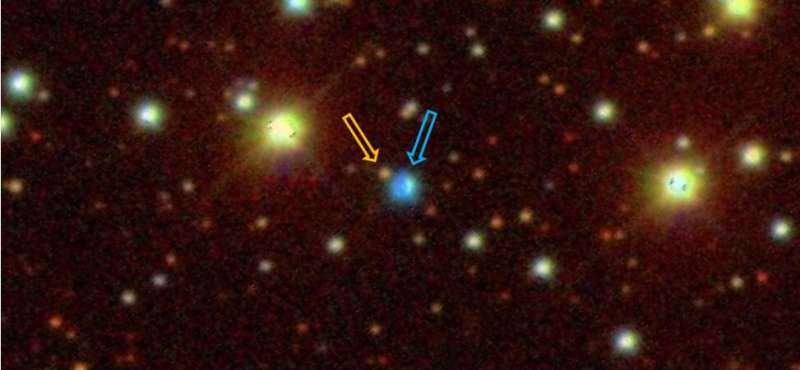July 13, 2023 report
This article has been reviewed according to Science X's editorial process and policies. Editors have highlighted the following attributes while ensuring the content's credibility:
fact-checked
trusted source
proofread
PM 1-322 is a variable planetary nebula, study finds

By analyzing the data from various ground-based facilities and space telescopes, European astronomers have investigated the nature of a peculiar object known as PM 1-322. As a result, they found evidence indicating that PM 1-322 is a variable planetary nebula. The finding was reported July 3 on the preprint server arXiv.
Planetary nebulae (PNe) are expanding shells of gas and dust that have been ejected from a star during the process of its evolution from a main sequence star into a red giant or white dwarf. They are relatively rare, but are important for astronomers studying the chemical evolution of stars and galaxies.
PM 1-322, with a G-band magnitude of 15.41, was first identified in 2005 and initially classified as a young PN on the basis of spectroscopic observations. However, other studies suggested that it is a symbiotic star, mainly due to its relatively high electron density. The distance to the object is estimated to be 6,800 light years.
Recently, a team of astronomers led by Ernst Paunzen of the Masaryk University in Brno, Czech Republic, has analyzed the archival data from the Zwicky Transient Facility (ZTF) and other telescopes, finding that PM 1-322 exhibits a long-term variability. The finding triggered follow-up observations of this object, which yielded more hints into its nature.
"Several archives were searched for historic photomeric data on our target object. The ZTF (Bellm et al, 2019) has observed this star in two filters (ZTF g and ZTF r) for more than four years," the researchers explained.
Paunzen's team detected an object and designated it ZTFJ201451.59+120353.4. The object identifies with PM 1-322 and showcases a very peculiar variability pattern. The ZTF r and g data show a one-magnitude deep, eclipse-like event with a duration of about half a year that occurred in 2022.
Moreover, the astronomers found that the variability is characterized by dimming events in the optical region that are accompanied by brightening events in the red and infrared regions. They also identified two fast eruption-like events in the ZTF r data.
By investigating the archival data from NASA's Wide-field Infrared Survey Explorer (WISE) spacecraft, it turned out that PM 1-322 experiences a long-term variability with a possible period of about six or 12 years. Follow-up photometric observations conducted by researchers detected also a stochastic short-term variability with an amplitude of about 0.1 mag on the timescale of about one hour.
In concluding remarks, the authors of the paper take into account several hypotheses that could explain the nature of PM 1-322, favoring the PN scenario—based on the high-resolution spectroscopy.
"Our most likely interpretation is that our target object involves a hot central star surrounded by gaseous and dusty disks, an extended nebula, and a possible companion star. Further observations are required to shed more light on the true nature of this enigmatic object," the astronomers concluded.
More information: E. Paunzen et al, PM 1-322: new variable planetary nebula, arXiv (2023). DOI: 10.48550/arxiv.2307.01331
© 2023 Science X Network


















